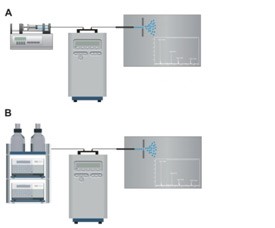CHIP CELL
The ChipCell is a specially designed reactor cell with very low volume (approx. 175 nL). It is ideal for small volume applications [1] and is typically used with flow rates in the range of 0.5 – 2.5 µL/min. The cell is made by a micromachining process, whereby a glass substrate is selectively etched to produce the desired channel structures. The cell can be used in direct infusion mode with nano ESI/MS detection. Since the dead-volume free assembly assures the preservation of the chromatographic separation, the cell can also be used after a Capillary- or Nano LC separation to provide on-line CapillaryLC/Electrochemistry/ MS.The chip is made of borosilicate glass with platinum (Pt) working, reference and counter electrodes. For optimal protection, the glass chip is delivered in a protective polymer cartridge of 75 x 25 mm, fully compatible with the ChipCell docking station.
- Small volume reactor cell (approx. 175 nL)
- Ideal for small flow rate applications, e.g., Capillary LC, Nano LC, etc.
- Easy handling
- All parts provided for immediate use
Esquema del sistema

(A) Schematics ChipCell set-up with ChipCell assembly on top of ROXY Potentiostat: Direct infusion mode for detection by nano ESI/MS
(B) and post-column separation mode, i.e., Nano LC/EC/MS mode, typical flow rates 0.5 to 2.5 uL/min
The ChipCell is based on a 3 electrode thin-layer flow cell concept, with a “Y” shape, comprising of one inlet port and two outlet ports with separated working (WE) and counter electrode (CE) in each of the channel arms. The reference electrode is located in close proximity to the inlet. The smooth surface of the working electrode (WE) integrated in one of the channel arms results in virtually zero sample adsorption and carry over. The outlet of the WE channel is connected to the nano ESI/MS, meanwhile the outlet of the CE channel (opposite channel arm) is usually diverted to waste. The glass chip is designed as a disposable component and can be easily replaced once it gets irreversibly clogged or damaged.

Oxidative metabolism of Amodiaquine (m/z 355) with the two major metabolite m/z 326 and m/z 299 using the ChipCell, scan mode 0 - 2.0V; 20mV/s; flow rate through working electrode channel (WE) ca. 500 nL/min.
The ChipCell is used with the ROXY Potentiostat and for direct infusion mode it is supplied with the appropriate syringe pump. For additional details, see the description of the ROXY EC system. The flow rate and working potential can be optimized using the Dialogue software or dedicated MS software, e.g., XCalibur.
|
Part no |
Description |
|
205.0035 |
ChipCell kit, consisting of three ChipCells in protectivecartridges, ChipCell docking station + frame and electricalconnections to the ROXY Potentiostat |
|
205.0150 |
100 μm ID, 1/16” PEEKSIL connection kit, consisting of alltubing, nuts and ferrules for connecting to the dockingstation, recommended for infusion mode EC/MS |
|
205.0152 |
25 μm ID, 1/16” PEEKSIL connection kit, consisting of alltubing, nuts and ferrules for connecting to the dockingstation, recommended for Capillary- or Nano LC/EC/MS |
|
|
|
|
205.0040 |
ChipCell docking station |
|
205.0045 |
ChipCell with Pt electrodes, 1 pcs |
|
250.0134 |
Cell cable for ChipCell |

